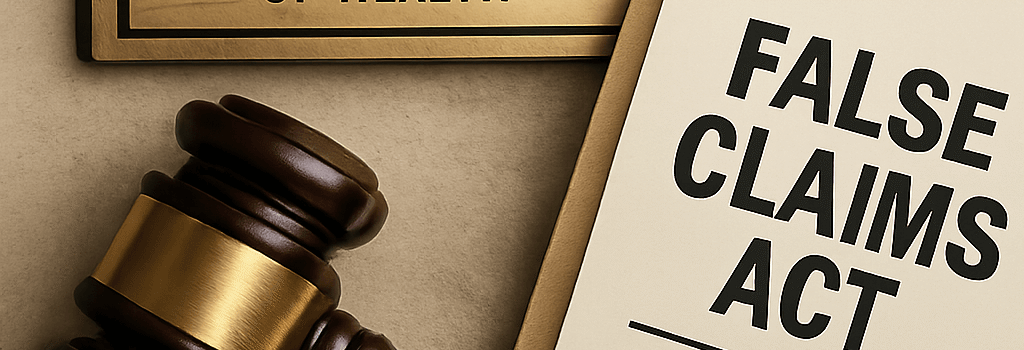NIH’s False Claims Act Clauses Raise Concerns at Universities

Earlier this year, a principal investigator at the University of Michigan was notified via the NIH eRA Commons portal that her multi‐year R01 grant (PA‐20‐014) was entering its next funding cycle. Yet just days later, university counsel issued a freeze on outgoing award payments. Behind the scenes, U-M and other top NIH recipients are wrestling with recently inserted language in the Notice of Award (NoA) that subjects grantees to liability under the Civil War-era False Claims Act (31 U.S.C. § 3729 et seq.) for any failure to comply with federal civil-rights statutes and a January 20, 2025 executive order on “biological sex.”
Grant Pauses at Michigan: A Case Study
The University of Michigan, among the top three NIH grantees in fiscal 2024 with over $750 million in active awards, quietly halted issuance of more than 270 NoAs between mid-April and early June. In private emails obtained under Michigan’s Freedom of Information Act, research administrators cite new compliance clauses tied to:
- Title VI of the Civil Rights Act of 1964 (42 U.S.C. § 2000d)
- Title IX of the Education Amendments of 1972 (20 U.S.C. § 1681)
- Executive Order 14069 (“Protecting Statutory Conscience Rights in Health Care,” Jan. 20, 2025)
Each NoA now includes a bullet stating that “a knowing false statement with respect to compliance” is actionable under the False Claims Act, potentially exposing institutions to treble damages and civil penalties of $11,665–$23,331 per violation.
Technical Specifications of NIH Notice of Award Changes
Under 2 CFR § 200.208, federal agencies may add special award conditions for high‐risk grantees. NIH’s new Special Award Condition references:
- Executive Order 14069’s directive to “use clear and accurate language” affirming that “women are biologically female, and men are biologically male.”
- A requirement to certify non-participation in discriminatory diversity, equity, and inclusion (DEI) programs or academic boycotts of Israel, per NIH’s April 21 policy memo.
- A False Claims Act attestation: grantees must acknowledge 31 U.S.C. § 3729 liability for any “false, fictitious, or fraudulent statements.”
These changes are routed through NIH’s electronic Research Administration (eRA) system. Once an institution clicks “Accept” in the eRA Commons NoA tab, the award is legally binding. This automated workflow gives little room for negotiation, forcing university legal offices to decide whether to sign and risk FCA exposure or delay funding indefinitely.
Legal Risks and False Claims Act Mechanics
Samuel Bagenstos, University of Michigan law professor and former HHS general counsel, warns that “the FCA is a potent weapon—one that can impose up to three times the government’s actual damages plus mandatory statutory penalties.” While Bagenstos and others believe such an FCA suit tied solely to Title VI/IX or executive order compliance would likely fail on First Amendment and Spending Clause grounds, the mere threat alarms risk-averse research institutions.
“With a qui tam provision, private relators can sue on behalf of the U.S. and claim up to 30% of any recovery. That incentivizes well-funded advocacy groups to bring suits not for genuine fraud detection but for ideological enforcement,” Bagenstos says.
Implications for Research Software and Infrastructure
Beyond raw funding, the standoff affects cloud and on-premise research computing. Institutions running NIH-funded workloads on AWS, Azure, or Google Cloud must comply with NIH’s Cloud Computing Security Requirements. Delays in NoAs disrupt data transfer agreements (DTAs), Virtual Private Cloud (VPC) peering, and allocation of NIH-approved IP ranges under NIH Data Management and Sharing Policy (NOT-OD-21-013).
James Maxwell, CTO at a leading academic computing consortium, notes: “If grant funds are on hold, we can’t provision necessary HPC clusters or renew SSH keys under NIH IP whitelisting. Delays cascade into stalled bioinformatics pipelines, expired FAIR data repositories, and jeopardized compliance with NIST SP 800-171.”
Comparative Analysis with Previous Funding Policies
Historically, NIH NoAs referenced general civil-rights compliance under 45 CFR 75.300 but did not invoke criminal statutes like the FCA. Under the Biden administration, directives focused on expanding DEI and data‐sharing mandates, with minimal legal penalty language. The Trump administration’s recent exec orders have reversed that trend, layering new restrictions that are unrelated to scientific aims and thus raise constitutional questions under South Dakota v. Dole (483 U.S. 203) regarding conditional spending.
Legal Pathways and Institutional Responses
Potential Litigation Strategies
Richard Epstein, at NYU School of Law, suggests a challenge under the Unconstitutional Conditions Doctrine. He argues that NIH’s “unrelated‐to‐programmatic‐science” mandates exceed the agency’s statutory grantmaking authority under 42 U.S.C. § 289a(a). A federal district court could issue an injunction pending review, citing NFIB v. Sebelius on coercive spending.
Role of Trade Associations
The Association of American Universities (AAU) and the Association of Public and Land-grant Universities (APLU) may coordinate a “mass action” lawsuit. Such a collective challenge could pool resources, share litigation costs, and present empirical data on adverse operational impacts across dozens of campuses.
Additional Expert Opinions and Next Steps
Andrew Twinamatsiko, from Georgetown’s O’Neill Institute, warns that ambiguous terms like “gender ideology” and “DEI activities” could trigger FCA suits based on subjective interpretations. “Without clear definitions in the Code of Federal Regulations, institutions face a moving target,” he says.
Legal scholars recommend that universities:
- Establish interoffice working groups between legal counsel, research finance, and compliance to interpret NoA language.
- Engage Congress to clarify statutory limits on NIH–imposed conditions under the Legislative Branch appropriations process.
- Consider early declaratory judgment actions to resolve ambiguity before funds are formally accepted.
Conclusion
The recent NIH award freeze at institutions like the University of Michigan underscores a broader tension between scientific autonomy and politically driven compliance mandates. With billions in federal support at stake, universities must weigh the risk of FCA exposure against the imperative to maintain uninterrupted research operations. As legal challenges loom, the resolution will shape not only the trajectory of U.S. biomedical innovation but also the contours of federal‐academic relations for years to come.